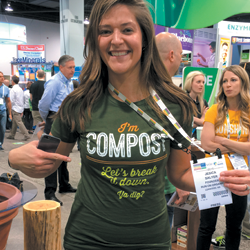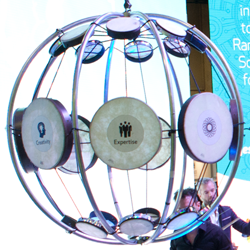 |

Bob Milam,
trade show manager at Kerry Americas, is a past All-Star Award winner, a current EXHIBITOR Editorial Advisory Board member, a Conference Advisory Board member, and an EXHIBITOR Conference faculty member.
tradeshowbob@gmail.com |
| |
 t's the sizzle that sells the steak. If you've ever sat in a restaurant and seen a sizzling plate go past, you know that appetizing, aromatic sizzle is what makes you turn to your waiter and ask, "Oh, what's that?" It catches your senses, piques your interest, and leaves you hungry for the promise of the savory flavor that sizzle represents. t's the sizzle that sells the steak. If you've ever sat in a restaurant and seen a sizzling plate go past, you know that appetizing, aromatic sizzle is what makes you turn to your waiter and ask, "Oh, what's that?" It catches your senses, piques your interest, and leaves you hungry for the promise of the savory flavor that sizzle represents.
Now imagine that your waiter or waitress turns to you and says, "That sumptuous smelling sizzle? No idea. Can I bring you a crust of bread and a glass of water?"
That's pretty much how I felt while observing a pair of exhibits at the 2008 Natural Products Expo. Both exhibits were great at attracting large crowds with their sizzle, but neither company seemed able to deliver the meat - to follow up the crowd-gathering technique with meaningful interaction with attendees.
Totally Twisted
The first company, a manufacturer of food ingredients, gathered a crowd of 15 to 20 attendees every 20 minutes using a female acrobat as bait. The young woman, dressed in a red sequined costume, stood on a balance beam perched on an elevated platform doing hand stands, the splits, and other contortionist acts while holding one of the company's product boxes.
Nothing wrong with that, you say? Well, not as such. Getting 20 people to spend a couple of minutes staring into your exhibit is never a bad thing. But my befuddlement came when I noticed that the booth staff didn't seem to know what to do with the crowd. At the end of each contorted performance, there was no call to action. No rush to get attendees' badges swiped or to ask qualifying questions. In fact, after each performance, the young woman would smile, put down her prop, and head to a little dressing room to get ready for her next turn on the platform; and inexplicably, the all-male staff would follow her to her sanctuary to chat.
OK, so maybe gathering leads wasn't the plan, you say. Well, then the master plan couldn't have been developing brand identity either. The company's colors - blue and white - didn't match the performer's outfit. And no messaging in the booth was tied to the lithe lady or her impressive display of flexibility either.
Still, everyone at the booth seemed happy with their exhibit. The sales staff watched her perform and spent plenty of time chatting with her. And the exhibit manager was thrilled with the crowds the performer was attracting. But as I watched this exhibit, I had to wonder: What was the purpose of gathering the crowd if staffers were just going to let it walk away each time?
Today's Special
The second exhibitor that perplexed me manufactured capsules, the empty pill shells into which a supplement supplier might pack its dietary aids. Each day, the company drew huge crowds with traffic builders that included Brad Pitt and Angelina Jolie (aka Brangelina) look-a-likes who posed for photos with attendees on day one; a sports theme that included free hot dogs, beer, and cheerleaders, again available for a photo op, on day two; and a daringly dressed female lion tamer (sans actual lion) who welcomed attendees to the "circus" with complimentary popcorn, a crack of her whip, and a photo op with Marcel, the monkey from the long-running NBC TV show "Friends," on day three.
To make sure no one missed these traffic-building themes, booth staffers walked the show floor in tuxedos (day one), football jerseys (day two), and clown attire (day three) with signs instructing attendees to follow them to the company's booth.
As luck would have it, this exhibit was right across the aisle from my own, so I got to watch closely as the crowds massed for free food and photos each day. But this also put me front and center to witness the disappointing follow-up performed by the company's booth staffers.
Three members of my booth staff - conspicuously hiding their badges so as to appear to be attendees - went over each day for a little look at their operation. No one was asked for qualifying information: Are you looking for gel caps? What does your company produce? Are you familiar with our product? Nothing.
The company's exhibit manager later informed me that the company's goals were to generate leads, but the lead forms occasionally carried by booth staffers seemed almost never to be sullied by any pesky information about the attendees that visited the booth. In the end, I was again left wondering, "What's the point of all this sizzle if there's no substance behind the traffic-building strategy?"
To Sizzle, or Not to Sizzle?
Make no mistake, attracting crowds is a difficult job, and both of these exhibits sizzled like a steak on a hot plate, attracting the attention of anyone within sniffing distance. But once those crowds were gathered, neither company made the effort to find the tasty morsels within each group. So to make sure your booth offers the steak and not just the sizzle, ask yourself these questions:
1. What is my goal for this show? Whether you're looking to qualify attendees on the show floor, swipe as many badges as possible for later vetting, meet individually with top clients, or just make sure your brand gets recognized at a show, your crowd-gathering technique should reflect your goal.
For example, if your company aims to collect loads of leads at the show, generating a ton of traffic is a logical strategy. Attracting a crowd would also make sense if your primary objective at the show is increasing brand or product awareness. But if your goal is simply to meet with existing clients for some quality face time, then creating traffic not only is unnecessary but could be a disadvantage, making you look too busy to meet with the existing clients who've come to see you.
2. How will I hook them? If you've come to the conclusion that a traffic-building strategy is in alignment with your company's objectives at the show, you have to brainstorm ways to generate the kind of traffic you want. And the best way to attract a crowd is, quite simply, to attract attention. Easier said than done, I know.
Common tactics include in-booth activities or presentations, high-value giveaways, contests, integrated marketing programs, etc. The trick is typically to stand out from the crowd. So examine what other exhibitors are doing, and then zig where they zag. Obviously, you want your traffic builder to tie to your company or product, or visitors are more likely to remember your promotion, but not your company's name. You'll become "that booth with the contortionist," and your goals of brand awareness will likely elude you.
So using the example of the contortionist, consider clothing her in your corporate colors, creating an audio track that incorporates key messages regarding your product's flexibility and/or your company's ability to bend over backward for its clients. Anything that marries your hook to your brand or key messages will help you make the most of your traffic-building tactics.
3. Now what? Once you've got a crowd of attendees in your booth, you need to capitalize on it.
With big crowds, having a plan to deal quickly and efficiently with attendees can be vital, but if your booth staff doesn't follow through with the plan, you'll have wasted that crowd as it eventually dissipates into neighboring exhibits.
So develop a plan and train your staffers. Using the contortionist example again, you and your entire staff should know exactly what to do the nanosecond each presentation is over. Whether it's scanning badges as people exit the booth, swooping in with qualifying questions and lead forms, or funneling them to product-demo stations, your plan should align with the objectives you've established for the show.
Attracting a crowd is not the goal; it's only the means to an end. Make sure your staffers understand this, and are ready and able to help you capitalize on your crowd and accomplish your objectives. Otherwise, those attendees will disappear like a restaurant that promises great steaks, but serves up chopped liver - and you'll be left with little to show for your sizzling exhibit-marketing efforts.e
|





 t's the sizzle that sells the steak. If you've ever sat in a restaurant and seen a sizzling plate go past, you know that appetizing, aromatic sizzle is what makes you turn to your waiter and ask, "Oh, what's that?" It catches your senses, piques your interest, and leaves you hungry for the promise of the savory flavor that sizzle represents.
t's the sizzle that sells the steak. If you've ever sat in a restaurant and seen a sizzling plate go past, you know that appetizing, aromatic sizzle is what makes you turn to your waiter and ask, "Oh, what's that?" It catches your senses, piques your interest, and leaves you hungry for the promise of the savory flavor that sizzle represents.


